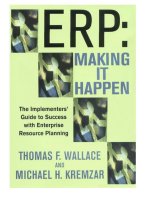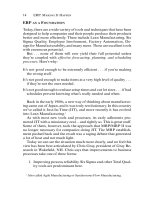Analyzing Big Data: The Path to Competitive Advantage
Bạn đang xem bản rút gọn của tài liệu. Xem và tải ngay bản đầy đủ của tài liệu tại đây (138.1 KB, 6 trang )
White Paper
Analyzing Big Data:
The Path to
Competitive Advantage
by Marcia Kaplan
Contents
Introduction 2
How Big is Big Data?. . . . . . . . . . . . . . . . . . . . . . . . . . . . . . . . . . . . . . . . . . . . . . . . . . . . . . . . . . . . . . . . . . . . . . . . . . . . . . . . 3
Why Use Big Data? 3
How Industries Use Big Data 4
Retail 4
Automotive 4
Healthcare. . . . . . . . . . . . . . . . . . . . . . . . . . . . . . . . . . . . . . . . . . . . . . . . . . . . . . . . . . . . . . . . . . . . . . . . . . . . . . . . . . . . . 4
Financial services 5
Challenges 5
Recommedations 6
®
®
About Ziff Davis B2B
Ziff Davis B2B is a leading provider of research to technology buyers and high-quality
leads to IT vendors. As part of the Ziff Davis family, Ziff Davis B2B has access to over
50 million in-market technology buyers every month and supports the company’s core
mission of enabling technology buyers to make more informed business decisions.
Contact Ziff Davis B2B
100 California Street, 6th Fl., San Francisco, CA 94111
Tel: 415.318.7200 | Fax: 415.318.7219
Email:
www.ziffdavis.com
Copyright © 2013 Ziff Davis B2B. All rights reserved.
ziffdavis.com
2 of 6
Ziff Davis | White Paper |
Analyzing Big Data — The Path to Competitive Advantage
ziffdavis.com
Introduction
Almost every business collects data, and the majority of it is about their customers. Over the
past several years the cost of storing data has decreased substantially, thanks mostly to cloud
solutions. Now companies gather huge amounts of information and store it just in case it may
turn out to be useful someday. Accumulating and storing data is easy. Organizing and analyzing
data and figuring out what is valuable are much more complex tasks. And knowing how to
extract meaningful, actionable insights is even more difficult, but is crucial to bolstering the
bottom line.
Big Data can solve those problems. With the appropriate software and tools, companies can
comb through the nonproductive, non-revenue-producing data in storage and analyze it to
identify business trends and reveal new opportunities.
Big Data is different from ordinary database information because of the massive volume, the
variety (structured, semi-structured, and unstructured), and the velocity. Now information such
as product reviews, e-mail, video, blogs, web log files, and Tweets are in the data mix. Social
media feedback has become a very useful research tool for businesses but sophisticated
analysis of the massive quantities was not possible before analytic tools were developed
specifically for Big Data. Additionally, Big Data encompasses data generated by machines
such as sensors.
ziffdavis.com
3 of 6
Ziff Davis | White Paper |
Analyzing Big Data — The Path to Competitive Advantage
How Big is Big Data?
In 2000, 800,000 petabytes of data were stored worldwide. (One thousand terabytes equals one
petabyte.) Today, Facebook alone generates ten terabytes of data every day and Twitter comes in
at seven terabytes.
About 90 percent of the available data in the world has been generated in the past two years.
Why Use Big Data?
Big Data analytic tools facilitate the examination of large amounts of different types of data to
reveal hidden patterns and correlations that are not otherwise easily discernible. Increasingly,
companies are spotting trends from social media that they quickly convert into new products or
add to existing products. Big Data can unlock significant value by making information transparent.
It helps companies make smarter, faster, and more strategic decisions.
IBM’s 2012 Big Data @ Work Survey of 1144 professionals found that 63 percent of
respondents reported that the use of information including Big Data and analytics is creating a
competitive advantage for their organizations. While over 50 percent of respondents stated that
they had not yet begun Big Data analysis, 47 percent planned to do so.
In another study, The Deciding Factor: Big Data & Decision Making, conducted by the Economist
Intelligence Unit for Capgemini, two-thirds of the executives note in the study that they consider
their organizations to be “data-driven,” meaning that data collection and analysis are the
foundation of their firms’ business strategies and day-to-day decision-making. The percentages
are highest in the energy, financial services, healthcare, and pharmaceuticals industries. More
than half of the respondents say management decisions that are based purely on intuition
or experience are increasingly regarded as questionable. And 65 percent affirm that more
management decisions are based on validated analytic information. That figure rises to 73 percent
for the financial services sector.
Big Data allows companies to make better decisions using existing and new data sources. It offers
the capability to better understand and predict consumer behavior. Real time data capture enables
faster decision-making, such as when a customer is on a website or on the telephone speaking
with a customer service representative.
The use of Big Data has improved the performance of businesses by 26 percent on average and
that influence will grow to 41 percent over the next three years, according to the Capgemini study.
ziffdavis.com
4 of 6
Ziff Davis | White Paper |
Analyzing Big Data — The Path to Competitive Advantage
How Industries Use Big Data
Retail
Retail is an obvious early adopter of Big Data with rich customer data helping
merchants to better personalize customer information and be more exacting about
inventory levels. Merchandising is currently the number one use of Big Data in retail.
Online merchants can analyze data on visitor browsing patterns, login counts, past
purchase behavior, and responses to promotions. Merchants can eliminate what
isn’t working and focus on what does. Some analytic solutions are so finely tuned
to dynamic pricing, they can tell a merchant whether it needs to offer a 25 percent
discount or if a 15 percent discount will suffice for a particular customer according to
Retention Science, a software company that helps clients retain customers using big
data analytics. Similar products can be cross-sold within seconds to a customer paying
at the cash register. Data analysis also allows for tighter control of inventory so items
aren’t overstocked
Automotive
Big Data is being utilized to accelerate product design, improve vehicle performance
and augment the driver experience. Sensor-generated data from onboard
communications, GPS, and telematics will become more important as manufacturers
move towards the “connected vehicle” with more than 10,000 sensors per vehicle
generating data that streams back to the manufacturer. Big Data analytics will propel
predictive maintenance as sensors provide data that can quickly flag atypical events
and alerts drivers to proactively take corrective actions.
Healthcare
More and more scientific advances owe their success to the ability of supercomputers
to rapidly crunch data. Currently, large datasets and algorithms present tantalizing
opportunities just waiting to be examined. With Big Data, that progress could extend to
the development of models and systems that track, sort, and analyze the development
of complex biological systems. Researchers could effectively polish their diagnostic and
predictive abilities to design and deliver solutions in fundamental research, drug design,
delivery, and eventual cure.
Big Data can be helpful in designing inclusion and exclusion criteria for clinical trials,
performing predictive models on virtual trials, identifying patients for recruitment, and
identifying unintended uses and indications. The McKinsey Global Institute estimates
that applying Big Data strategies to healthcare decision-making could generate up
to $100 billion annually in the United States alone. In their article, “How big data can
ziffdavis.com
5 of 6
Ziff Davis | White Paper |
Analyzing Big Data — The Path to Competitive Advantage
revolutionize pharmaceutical R&D,” authors J. Cattell, S Chilukuri, and M. Levy foresee
that predictive modeling of biological processes and drugs could become significantly
more sophisticated. By leveraging the diversity of available molecular and clinical data,
predictive modeling could help identify new potential-candidate molecules with a high
probability of being successfully developed into drugs that act on biological targets
safely and effectively.
Financial services
In most financial institutions the current use of big data is to contain fraud and comply
with rules on money laundering. Predictive credit risk models that tap into large
amounts of payment data are being adopted in consumer and commercial collections
practices to help prioritize collections activities.
Financial services companies are looking to leverage large amounts of consumer data
across multiple service delivery channels to uncover consumer behavior patterns and
increase conversion rates, according to The Deciding Factor: Big Data & Decision
Making, a report written by the Economist Intelligence Unit for consulting firm
Capgemini.
Challenges
The biggest current challenge is being able to articulate a compelling business case for using
Big Data. Most companies are unsure of the value of a lot of data they already have collected.
Advanced analytic capabilities are necessary to make the data actionable.
Other challenges include organizations silos that interfere with decision-making. If
departments don’t share data, the customer profile is incomplete. Another problem is a
shortage of qualified Big Data scientists. A lack of qualified people is impeding Big Data
implementations and a talent shortage is driving up costs. Deloitte is projecting a need for up
to 190,000 skilled professionals to cope with demand in the U.S. over the next five years.
ziffdavis.com
6 of 6
Ziff Davis | White Paper |
Analyzing Big Data — The Path to Competitive Advantage
Recommendations
• Start small using existing data with which you are already comfortable. Keep things
simple and then move on to more complex uses.
• Focus on functions that you believe can drive the most improvement. This will help build
a business case for the usefulness of Big Data.
• Commit initial efforts to customer-centric outcomes.
Remember — while you may be holding back on Big Data implementation, your competitors
are using it to gain an advantage over you.









